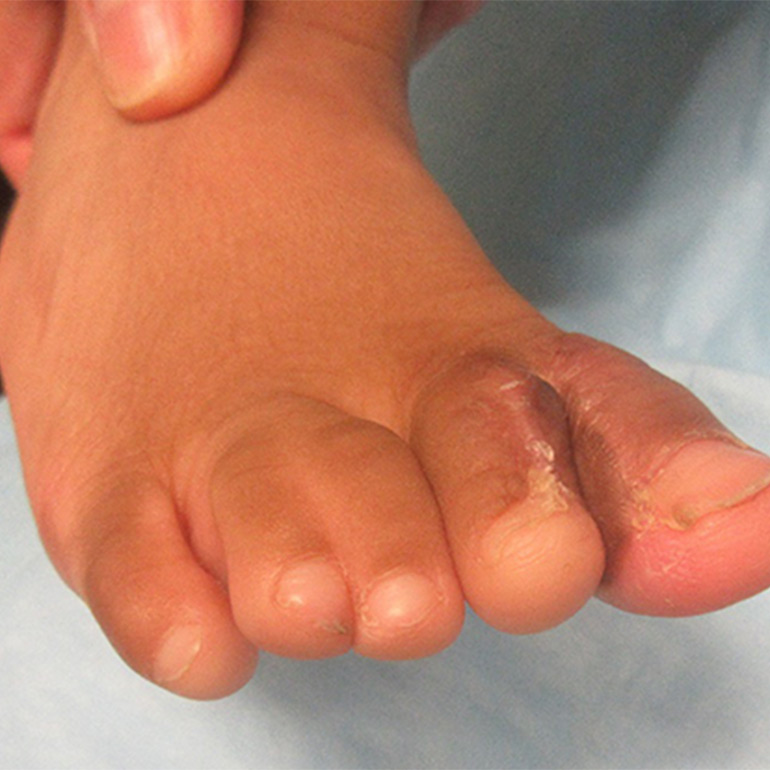
Expert Syndactyly Care
Syndactyly is a common congenital condition where fingers or toes are fused together, requiring specialized surgical separation and reconstruction. Our board-certified plastic surgeon specializes in the treatment of syndactyly, using advanced techniques to separate fused digits and create normal web spaces while preserving function and sensation.
We understand the functional and aesthetic concerns associated with syndactyly. Our comprehensive approach includes careful preoperative planning, precise surgical execution, and attentive postoperative care to ensure optimal results. Whether treating simple or complex cases, we provide personalized care to restore normal hand or foot appearance and function. Contact us today to discuss treatment options for your child.
Comprehensive Syndactyly Treatment
At our practice, we take a meticulous approach to syndactyly correction, addressing both the functional and cosmetic aspects of this condition. Our treatment involves careful planning to ensure optimal separation, adequate skin coverage, and proper web space reconstruction while preserving neurovascular structures.
- Expert surgical separation of fused fingers or toes
- Precise reconstruction of natural web spaces
- Preservation of nerve and blood vessel function
- Advanced techniques for optimal cosmetic results
- Comprehensive postoperative care and rehabilitation
Types of Syndactyly We Treat
Our expertise covers the full spectrum of syndactyly presentations, from simple skin connections to complex bony fusions involving multiple digits.
By Complexity
- Simple syndactyly (skin connection only)
- Complex syndactyly (bone fusion)
- Complete syndactyly (full-length fusion)
- Incomplete syndactyly (partial fusion)
- Complicated syndactyly (with other anomalies)
By Location
- Finger syndactyly (most common)
- Toe syndactyly
- Bilateral involvement
- Multiple digit involvement
- Web space reconstruction
Surgical Techniques & Timing
Syndactyly repair requires careful timing and specialized surgical techniques to achieve optimal functional and aesthetic outcomes.
Surgical Techniques
- Z-plasty and W-plasty incisions
- Skin grafting techniques
- Web space reconstruction
- Microsurgical nerve preservation
- Vascular anatomy preservation
Optimal Timing
- Finger separation: 6-18 months
- Thumb-index web: 6-12 months
- Border digits: Earlier intervention
- Central digits: Staged procedures
- Complex cases: Individualized planning
Benefits of Syndactyly Correction
Surgical correction of syndactyly provides significant improvements in both function and appearance, enabling normal development and activity participation.
Functional Improvements
- Independent finger movement
- Improved grip and dexterity
- Normal hand function development
- Proper sensory perception
- Enhanced fine motor skills
Aesthetic & Psychological Benefits
- Normal hand appearance
- Improved self-confidence
- Reduced social concerns
- Better social integration
- Normal shoe fitting (for toe syndactyly)
Frequently asked questions
Understanding Syndactyly Treatment
Syndactyly surgery is typically performed between 6-18 months of age. The exact timing depends on which fingers are involved and the complexity of the condition. Border digits (thumb-index or ring-small finger webs) are often treated earlier (6-12 months) to prevent growth disturbances, while central digits may be addressed slightly later. Early intervention allows for normal hand development and function while the child is still developing motor skills.
Most syndactyly procedures require skin grafts to provide adequate coverage after separation. The skin graft is typically taken from the groin area, which provides an excellent color and texture match and leaves a well-hidden scar. In some simple cases or when only a small amount of skin is needed, local flaps may be sufficient without grafting. We use advanced techniques to minimize donor site morbidity and ensure the best possible aesthetic outcome.
Recovery typically involves 2-3 weeks of cast immobilization to protect the surgical site and allow proper healing. After cast removal, gentle movement and therapy begin. Most children resume normal activities within 4-6 weeks. We provide detailed postoperative instructions and close follow-up care. Long-term results continue to improve as scars mature over 6-12 months. Occupational therapy may be recommended to optimize functional outcomes, particularly for complex cases.
Most children achieve excellent functional outcomes after syndactyly surgery. The goal is to restore independent finger movement and normal hand function. Simple syndactyly cases typically achieve near-normal function, while complex cases may have some limitations depending on the original anatomy. Early intervention helps support normal development of fine motor skills. We use techniques that preserve nerves and blood vessels to maintain sensation and circulation. Regular follow-up ensures optimal functional recovery.
